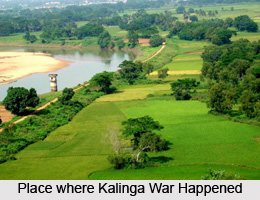 History of Nabarangpur district, until recently called as Nowrangpur, was a part of erstwhile Koraput District ruled by the Solar Dynasty of Jeypore in the past. It was a grant received from the Maharaja of Jeypore in the year 1820 AD. The language, style of living, heritage, geographical location, flora and fauna and even climate of Nabarangpur is not dissimilar from the rest of the component of Koraput district. Its boundary stretches in the north to Kalahandi district west to Jagadalpur district in Chhatishgarh, east to Kalahandi and Rayagada and south to Koraput district with the river Indravati separating the two districts. Nabarangpur is located on the 2000 ft Plateau (about 2000 ft above mean sea level) like that of the historically, famous Jeypore town in the Koraput district.
History of Nabarangpur district, until recently called as Nowrangpur, was a part of erstwhile Koraput District ruled by the Solar Dynasty of Jeypore in the past. It was a grant received from the Maharaja of Jeypore in the year 1820 AD. The language, style of living, heritage, geographical location, flora and fauna and even climate of Nabarangpur is not dissimilar from the rest of the component of Koraput district. Its boundary stretches in the north to Kalahandi district west to Jagadalpur district in Chhatishgarh, east to Kalahandi and Rayagada and south to Koraput district with the river Indravati separating the two districts. Nabarangpur is located on the 2000 ft Plateau (about 2000 ft above mean sea level) like that of the historically, famous Jeypore town in the Koraput district.
The history of Nabarangpur district in Orissa, which was in the past a part of Koraput, have experienced the rule of several dynasties. The Atavika people were native of Koraput, and valiantly fought the Kalinga war in the 3rd century BC. Kalinga regained her former glory during Mahamegha Bahan dynasty in the first century BC. The third king of this dynasty Kharabela made the Kalinga Empire and the Atavika land very strong. The successive dynasties - the Satavahans (2nd century AD), the Ikshvakus (3rd century AD), the Nalas (3rd and 4th century AD) ruled the Nabarangpur district. The Kesaribeda excavations bear testimony to the rule of King Bhabadatta Verman and King Arathapati. The inscriptions of Podagarh refer to King Skanda Verman .The Nala King are traced to the kings who ruled from Gwalior in Madhya Pradesh. Their rapid growth landed them in Bastar in the Koraput region. Around 10th century AD one of the Nala kings Bhimsen, was ruling over a region now located to the Koraput and Ganjam District.
The erstwhile Koraput was a small principality of Tri Kalinga under the Ganga era during the 5 the century AD. The patches of Odra, Kalinga and Kosala were brought under the power of Ganga kings. This dynasty became well-known during the 11th century AD with the rise of Somanakshi. Their suzerainty extended from the modern Sambalpur, Sonepur to Bastar - Koraput regions and they enjoyed their being in command till the beginning of 14th century AD. The next dynasty belonged to the Famous Sailavansis, who ruled over Vindhya during the 14th century AD. The last king of Sailavansa, Pratap Ganga Raju, was succeeded by Vinayak Dev of Surya Vansa which lasted till the eon of the British Empire. During the anglo- French conflict, Vikram Dev I was successful in driving out the French from Malkangiri area and the Marathas from the Umerkote belt. King Vikram Dev I (1758 -1781 AD) was succeeded by Ramachandra Dev-II (1781 -1825) while his other two sons Jagannath and Narasingh Dev were placed in charge of Nabarangpur and Gudari regions. Jagannath Dev`s son Arjun Dev and Narasingha Dev`s son Chaitanya Dev were issueless. Hence, Nabarangpur and Gudari were remerged to Jeypore kingdom.
During the 20th century Ramachandra Dev-IV (1920-31) was an honourable lieutenant in World War-I. He was issueless and was succeeded by Vikram Dev IV, the son of Krishna Chandra Dev. During this period the Boundary Commission headed by Sir O`Donnel was delegated with the task of writing the different Oriya speaking tracts. The Commission went round Jeypore, Paralakhumendi, Ganjam, and Visakhapatnam agency before finalising. The state of Orissa was formed on 1st April 1936 with Koraput as one of the six districts. In the year1951 Vikram Dev IV died and the Estate abolition Act was passed the year after. The Estate of Jeypore was taken over by Government of Orissa. And on 2nd October 1992, the district of Nabarangpur was inaugurated.



















